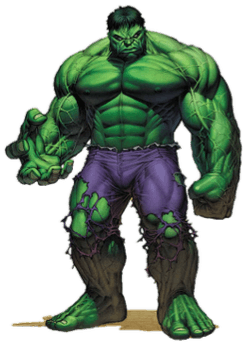Hulk facts for kids
Quick facts for kids Bruce BannerHulk |
|
|---|---|

Cover art for the comic book issue Immortal Hulk #20 (July 2019)
Art by Dale Keown and Peter Steigerwald |
|
| Publication information | |
| Publisher | Marvel Comics |
| First appearance | The Incredible Hulk #1 (May 1962) |
| Created by | Stan Lee Jack Kirby |
| In-story information | |
| Alter ego | Robert Bruce Banner |
| Species | Human mutate |
| Place of origin | Dayton, Ohio |
| Team affiliations | Avengers Defenders Horsemen of Apocalypse Fantastic Four Pantheon Warbound S.M.A.S.H. Secret Avengers |
| Notable aliases | Joe Fixit, War, World-Breaker, Doc Green, Devil Hulk |
| Abilities | As Bruce Banner:
As Hulk:
|
The Hulk is a famous superhero from Marvel Comics. He was created by writer Stan Lee and artist Jack Kirby. The Hulk first appeared in a comic book called The Incredible Hulk in May 1962.
In the comics, the character is actually two different people. One is the Hulk, a huge, green, super-strong being. The other is Dr. Robert Bruce Banner, a smart but quiet scientist. These two parts of him are separate personalities and often don't like each other.
[[Hulk1.jpg|thumb|left|The Incredible Hulk #1 (May 1962). Cover art by Jack Kirby and Paul Reinman.]] Bruce Banner became the Hulk after a lab accident. He was exposed to gamma rays while saving a friend, Rick Jones, from an exploding bomb. Now, whenever Banner gets very stressed or angry, he changes into the Hulk. This often causes a lot of damage and trouble for Banner's normal life. The angrier the Hulk gets, the stronger he becomes!
The Hulk is usually shown as a wild, raging monster. But he has also had other personalities. Sometimes he's a mindless force, other times a clever warrior, or even a genius scientist. Even though both Hulk and Banner often want to be left alone, they have many friends and allies. These include Banner's girlfriend Betty Ross, his best friend Rick Jones, his cousin She-Hulk, and his therapist Doc Samson. The Hulk also has superhero friends like the Avengers, and his own family like his queen Caiera and sons Skaar and Hiro-Kala.
Because of his amazing power, the Hulk sometimes fights with other heroes. But he always tries to do what is right. He also battles many villains like the Leader, Abomination, and Absorbing Man.
Contents
How the Hulk was Created
Stan Lee said he got the idea for the Hulk from two classic stories: Frankenstein and Dr. Jekyll and Mr. Hyde. He liked the idea of a character who was not perfect and who changed between a normal person and a powerful alter ego.
Jack Kirby, the artist, was inspired by seeing a mother lift a car off her trapped child. This showed him how strong someone could become in an emergency.
When the Hulk first appeared, Stan Lee wanted him to be grey. He thought this color would not suggest any specific group of people. However, the colorist had trouble keeping the grey consistent. So, after the first comic issue, Lee decided to make the Hulk green instead. For many years, even old comics were recolored green. But later, Marvel decided that the Hulk was originally grey in the story, and then became green.
Stan Lee liked to give his characters names where both parts started with the same letter, like "Bruce Banner." This helped him remember them. Sometimes he accidentally called him "Bob Banner," so the character's full name became "Robert Bruce Banner."
The Hulk in Popular Culture
The Hulk is one of the most well-known characters in the world. You can find him on clothes, toys, and even in theme park rides! He has appeared in many movies, TV shows, and video games.
In live-action movies, Eric Bana first played the Hulk. Later, in the Marvel Cinematic Universe (MCU), Edward Norton played Bruce Banner in The Incredible Hulk (2008). After that, Mark Ruffalo took over the role. He has played the Hulk in many popular MCU movies, including The Avengers (2012), Avengers: Age of Ultron (2015), Thor: Ragnarok (2017), Avengers: Infinity War (2018), and Avengers: Endgame (2019). Mark Ruffalo will also be in upcoming Disney+ shows like What If...? and She-Hulk.
Related pages
- The Incredible Hulk (1978 TV series)
- Hulk 2003 film
- The Incredible Hulk (film), 2008
- The Incredible Hulk (1996 TV series)
- The Incredible Hulk (1982 TV series)
- The Incredible Hulk Coaster
- The Incredible Hulk (2008 video game)
- The Incredible Hulk: Ultimate Destruction
Images for kids
-
The Incredible Hulk #1 (May 1962). Cover art by Jack Kirby and Paul Reinman.
See also
 In Spanish: Hulk para niños
In Spanish: Hulk para niños


